Heat Shielding
A heat shield is designed to shield some part of equipment from absorbing excessive heat from an outside source by either dissipating, reflecting or simply absorbing the heat.
Due to the large amounts of heat given off by internal combustion engines, especially exhausts, heat shields are used on most engines to protect components and bodywork from heat damage.
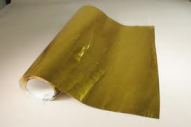 |
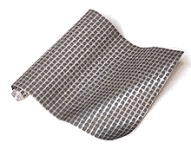 |
Heat shielding gold foil |
ZircoFlexTM Heat Shield Heat shielding flexible aluminium heat shield with ceramic thermal coating |
Heat shields vary widely in price. In Formula 1, the rigid heat shield are made out of aluminium or gold sheet or other composites, with a ceramic thermal barrier coating to improve the heat insulation. High performance flexible heat shields sometimes include extras, such as ceramic insulation applied via plasma spraying.

Most used is gold sheet, and we can see it very often on lower wing element or, before 2014 rules change, covering rear suspension wishbones to protect them from heat from exhaust. As heat shielding, apparently very, very thin layers will effectively reflect radiant heat with almost no mass, needing only to be a few atoms thick to do the job, and gold's extreme malleability allows making these thin foils.
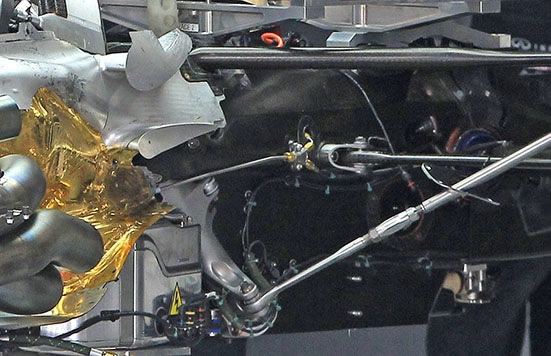 |
Red Bull racing gold foil heatshilding in area around exhaust to protect engine, gearbox and some other vital parts in this area |
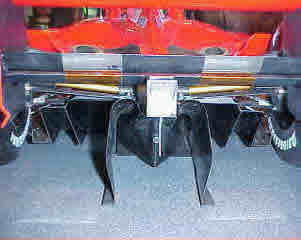
Road car fans will recall that BMW used gold-sheet heat shielding in the installation of the 6L V-12 used in the McLaren F1 road car. Gordon Murray elected to line almost the entire engine bay of the McLaren F1 with gold cladding because of its superior reflectivity and thermal diffusivity.

But as we can see in case of RedBull and Ferrari cars, in area around low exhaust bodywork with blown diffuser, no gold foil can be seen (with exception of wishbones). With more effective designs to pull the exhaust gases down to the car's floor to seal the diffuser, its carbon fibre floor is also exposed to the heat of the hot exhaust gases flowing over the floor. Such single sided heat exposure is a risk for the carbon fibre laminate which may end up slightly bent, creating an unwanted effect on the car's aerodynamics. The severity of this very much depends on the exact thermal conductivity of the carbon fibres and the temperature resistance of the resin between the sheets. Coatings like Zircotec's Performance range (known to be used in F1) are obvious candidates for this.
Modern technology offer other solution when structural integrity and strength is needed. Two strange materials are called „PyroSyc“, and is invention of „Pyromeral Systems“ and Zircotech, product of "Zircotech Heat management".
After 10 years of development, Pyromeral Systems has introduced an entirely new generation of materials that finally brings the advantages of composites to the world of high temperatures. With this technology, it is now possible to design and manufacture lightweight composite parts used at high temperatures that not only provide an excellent level of thermo-mechanical performance, but also remain easy and affordable to produce. They can be applied to a range of thicknesses from very thin (say 0.05mm thick) up to say 0.5mm thickness depending upon the required level of protection. Teams are also often requesting the coatings to be coloured to help disguise where they are used and which ones exactly are used.
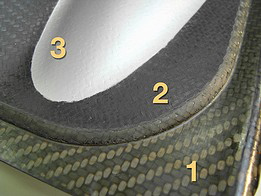 |
Hybrid composite material: |
These new composite materials, marketed under the PyroSic® and PyroKarb™ names, are based on proprietary glass-ceramic matrix systems reinforced with silicon carbide or carbon fibers. Thanks to the use of advanced inorganic polymers, they are processed at low temperatures with the same techniques and tooling as those used for conventional carbon-fiber reinforced plastics (CFRP). 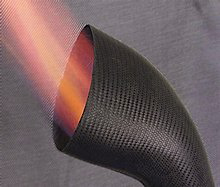 Yet, they also offer a much improved resistance to heat and fire, as they retain good mechanical properties at temperatures for which CFRP cannot even be considered (typically, up to 1000°C/1800°F). Material is lightweight, especially compared to metals like steel, inconel or titanium, have an excellent resistance to long term exposure up to 1000°C (1800°F) depending on the reinforcement, is compatibility with applications requiring good mechanical strength and resistance to vibrations, have dimensional stability at high temperatures. However this material is not permitted by FIA technical regulation to be used like exhaust building material. By fia rules, exhaust can be build only with metalic materials. During 2011 preseason testing Ferrari wanted to produce the exhaust in glass ceramic composite (such as PyroSic), but this request was denied by technical delegate Charlie Whiting who clarified the exhaust must be made of materials on the permitted materials list. Such composites, while allowed to be used in some other areas, are not allowed to be the actual material of the exhaust pipe.
Yet, they also offer a much improved resistance to heat and fire, as they retain good mechanical properties at temperatures for which CFRP cannot even be considered (typically, up to 1000°C/1800°F). Material is lightweight, especially compared to metals like steel, inconel or titanium, have an excellent resistance to long term exposure up to 1000°C (1800°F) depending on the reinforcement, is compatibility with applications requiring good mechanical strength and resistance to vibrations, have dimensional stability at high temperatures. However this material is not permitted by FIA technical regulation to be used like exhaust building material. By fia rules, exhaust can be build only with metalic materials. During 2011 preseason testing Ferrari wanted to produce the exhaust in glass ceramic composite (such as PyroSic), but this request was denied by technical delegate Charlie Whiting who clarified the exhaust must be made of materials on the permitted materials list. Such composites, while allowed to be used in some other areas, are not allowed to be the actual material of the exhaust pipe.
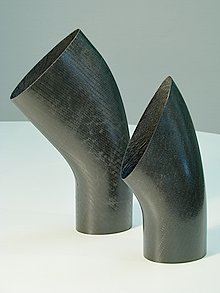 PyroSic materials are glass-ceramic matrix composites based on inorganic thermoset polymers. The glass-ceramic matrices specifically feature a glassy phase containing silicon oxide nanoparticles. These matrices are derived from geopolymeric systems and inherently resistant to heat and fire.
PyroSic materials are glass-ceramic matrix composites based on inorganic thermoset polymers. The glass-ceramic matrices specifically feature a glassy phase containing silicon oxide nanoparticles. These matrices are derived from geopolymeric systems and inherently resistant to heat and fire.
Applications for PyroSic and PyroKarb include heat shields, exhaust ducts, pipes for hot fluids or gases, fire barriers and other structural components. The materials are typically used in the field of motorsports, aerospace, defense, naval or automotive, either as a replacement of metals for weight reduction purposes, or as a replacement/complement for CFRP for improved thermal stability.
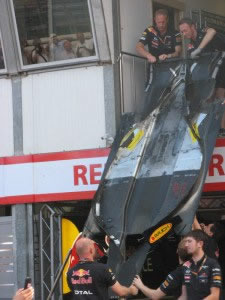 |
Heat protection within the engine bay on Red Bull Racing floor is a coating applied to carbon fiber floor with Zircotech ZircoFlex (silver color). Additional heat protection is provided with separate gold foil heat shields under the exhaust area. |
Zircotech is another highly recognized company which have developed a range of ultra high performance plasma-sprayed ceramic coatings to protect components from the effects of fire, heat, wear, abrasion and corrosion. Ceramic coatings are highly effective when used on engine exhaust system components including exhaust manifolds, exhaust headers, cat boxes, turbochargers and tail pipes, they keep heat inside the exhaust to prevent damage to surrounding components and helping to protect sensitive parts from the effects of heat. They reduce temperatures, increase engine performance, help solve engine packaging issues, and improve engine compartment safety. Based on proprietary ThermoHold® formulation, these ceramic coatings can only be applied by Zircotec. Zircotec products are in widespread use at all levels of motorsport including F1, NASCAR, World Rally and Le Mans. They have been suppliers to both F1 and World Rally for more than 12 years, and in 2010 Zircotec products are used by more than 70% of the teams in F1. Zircotec ceramic coatings are light weight and highly durable, lasting up to three seasons in many motorsport applications. They can also help engineers deliver more power by reducing engine air intake temperatures.
 |
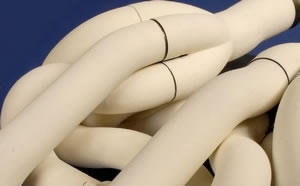 |
Zircotech carbon composite coating for heat shielding |
Zircotech ceramic exhaust coating and heat shielding |
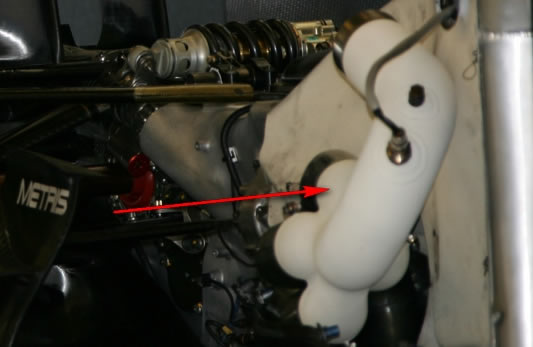 |
|
In addition to coatings they offer a self-install flexible ceramic heat shield material ZircoFlex. Typical applications include:
-
Heat protection for vulnerable underbonnet components.
-
Bodywork protection.
-
Reduction of heat soak through footwells, bulkheads, etc.
Zircotec developed technology and is able to manufacture some extremely complex ceramic structures. To do this they use an automated robotic plasma-spray facility.
One area of advancement with particular relevance to racing applications has been the development of CFRP (carbon fibre reinforced polymer) that can resist high temperature environments while retaining their mechanical properties.
With regular epoxy resins used with carbon fiber composites only being suitable for use below 300°C, teams have had to look at protecting these exposed panels or finding other resin systems to ensure structural integrity. The carbon fibres themselves will not fail due to exposure to high temperatures. In the extreme you can set fire to a section of carbon fibre epoxy composite and the fibre will be untouched; it is the resin system that will break down and burn off.
For temperatures below about 430°C, cyanate ester-based resins are favoured. Cyanate ester-based resins are originally developed by the aerospace industry for use in missile systems.
Cyanate esters are chemical substances generally based on a bisphenol or novolac derivative, in which the hydrogen atom of the phenolic OH group is substituted by a cyanide group. Cyanate ester resins are characterized by glass transition temperatures up to 400°C, excellent dielectric and mechanical properties and an epoxy-like processing providing excellent long term thermal stability at elevated end use temperatures, very good fire, smoke and toxicity performance. Cyanate esters can be cured and postcured by heating, either alone at elevated temperatures or at lower temperatures in presence of a suitable catalyst. Areas of use are electronics, aerospace, automotive and industrial composites and compounds.
For applications that exceed the maximum temperature for cyanate ester-based epoxies, things get more complicated as suitable composites tend to require complex high-temperature processes for their production, and do not exhibit the same material properties as normal CFRP. These include materials such as the carbon-carbon composites found in brake and clutch applications and ceramic-matrix composites, which can withstand temperatures up to 1000°C.
However, the appearance of a new generation of carbon fibre consisting of glass-ceramic matrices resulting from the polymerisation of inorganic polymers presents some interesting options for Formula One teams. These inorganic polymers are derived from alumino-silicate-based geopolymeric systems and, as such, differ significantly from both organic polymers and conventional ceramic matrices. The result is a lightweight alternative to metals and other materials for heat shields, ducts and other components exposed to temperatures of between 300 and 1000°C.
Ceramic matrix composites (CMC) are a subgroup of composite materials as well as a subgroup of technical ceramics. They consist of ceramic fibers embedded in a ceramic matrix, thus forming a ceramic fiber reinforced ceramic (CFRC) material. Characteristic of CMC is the matrix made of a ceramic material embedded between the fibres. Typical fibrous materials include carbon, silicon carbide, aluminium oxide and mullite. Aluminium oxide, zirconium oxide and silicon carbide are chiefly used as matrix components.
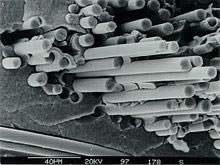 Ceramic matrix composites (picture left - microscopic view) have had a stormy development wherever the combination of breakage resistance and strength of conventional technical ceramics such as aluminium oxide, silicon carbide or zirconium oxide prove inadequate. Because even small production errors or scratches on the surface of conventional ceramics can lead to cracks forming, their use in many applications had always been impossible. Only the embedding of fibres proved capable of increasing the resistance to cracks and ductility, breakage strength and thermal shock resistance, sometimes drastically. The high fracture toughness or crack resistance is a result of the following mechanism: under load the ceramic matrix cracks, like any ceramic material, at an elongation of about 0.05%. In CMCs the embedded fibers bridge these cracks.
Ceramic matrix composites (picture left - microscopic view) have had a stormy development wherever the combination of breakage resistance and strength of conventional technical ceramics such as aluminium oxide, silicon carbide or zirconium oxide prove inadequate. Because even small production errors or scratches on the surface of conventional ceramics can lead to cracks forming, their use in many applications had always been impossible. Only the embedding of fibres proved capable of increasing the resistance to cracks and ductility, breakage strength and thermal shock resistance, sometimes drastically. The high fracture toughness or crack resistance is a result of the following mechanism: under load the ceramic matrix cracks, like any ceramic material, at an elongation of about 0.05%. In CMCs the embedded fibers bridge these cracks.
The potential for this material is exciting for engineers as it opens up some previously unexplored applications for composites.
Back to the top of the page






